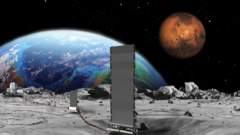In a bold move, NASA is accelerating its plans to deploy a nuclear reactor on the Moon by 2030, reflecting growing ambitions to establish a permanent human presence on the lunar surface. This strategy was reported by US media, highlighting the urgency amid increasing competition from China and Russia. Acting NASA Administrator Sean Duffy emphasized the need for swift action, stating that these geopolitical pressures could lead to conflicting territorial claims on the Moon.
NASA's plans, however, are met with skepticism regarding their fiscal and operational viability. Recent significant budget cuts focused on NASA's programs have raised doubts about this timeline. Experts question whether the agency can truly meet this ambitious goal while assuring safety in launching radioactive materials necessary for the reactor.
Already in 2022, NASA allocated $15 million for design contracts aimed at creating nuclear reactor concepts. Duffy's directive calls for commercial proposals that can produce at least 100 kilowatts of power, although this is modest compared to the energy requirements for sustaining human life in lunar habitats. Researchers point out that reliance on solar power is inadequate due to the Moon's extended periods of darkness.
Dr. Sungwoo Lim of the University of Surrey argues that nuclear power is necessary for continuous energy supply, suggesting that nuclear energy is not just a preference but vital for future lunar economies. Lionel Wilson from Lancaster University believes engineering potential exists to meet this ambitious timeline provided funding is sufficient.
Though scientists agree on the technical feasibility, they voice concerns over safety during the launch of nuclear materials. The logistics of a lunar colony hinge on NASA's Artemis program, aimed at delivering supplies and personnel to the Moon. Still, doubts linger about the coherence and planning necessary to successfully establish a nuclear infrastructure without proper groundwork.
Duffy's comments about potential territorial claims by rival nations refer to the Artemis Accords signed in 2020, aimed at creating cooperative frameworks for lunar exploration. Nonetheless, there looms a persistent worry that national agendas could overshadow scientific goals, as expressed by Dr. Simeon Barber of the Open University, who cautions against a narrow focus driven purely by competition.
With the Artemis 3 mission expected to return humans to the lunar surface in 2027, the uncertainty surrounding funding and strategy raises more questions than answers. As the space race intensifies, the stakes of lunar exploration continue to evolve, emphasizing the essential balance between collaborative exploration and competitive claims on celestial territory.
NASA's plans, however, are met with skepticism regarding their fiscal and operational viability. Recent significant budget cuts focused on NASA's programs have raised doubts about this timeline. Experts question whether the agency can truly meet this ambitious goal while assuring safety in launching radioactive materials necessary for the reactor.
Already in 2022, NASA allocated $15 million for design contracts aimed at creating nuclear reactor concepts. Duffy's directive calls for commercial proposals that can produce at least 100 kilowatts of power, although this is modest compared to the energy requirements for sustaining human life in lunar habitats. Researchers point out that reliance on solar power is inadequate due to the Moon's extended periods of darkness.
Dr. Sungwoo Lim of the University of Surrey argues that nuclear power is necessary for continuous energy supply, suggesting that nuclear energy is not just a preference but vital for future lunar economies. Lionel Wilson from Lancaster University believes engineering potential exists to meet this ambitious timeline provided funding is sufficient.
Though scientists agree on the technical feasibility, they voice concerns over safety during the launch of nuclear materials. The logistics of a lunar colony hinge on NASA's Artemis program, aimed at delivering supplies and personnel to the Moon. Still, doubts linger about the coherence and planning necessary to successfully establish a nuclear infrastructure without proper groundwork.
Duffy's comments about potential territorial claims by rival nations refer to the Artemis Accords signed in 2020, aimed at creating cooperative frameworks for lunar exploration. Nonetheless, there looms a persistent worry that national agendas could overshadow scientific goals, as expressed by Dr. Simeon Barber of the Open University, who cautions against a narrow focus driven purely by competition.
With the Artemis 3 mission expected to return humans to the lunar surface in 2027, the uncertainty surrounding funding and strategy raises more questions than answers. As the space race intensifies, the stakes of lunar exploration continue to evolve, emphasizing the essential balance between collaborative exploration and competitive claims on celestial territory.


















